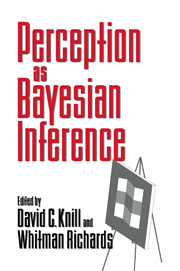Book contents
- Frontmatter
- Contents
- List of contributors
- Preface
- 0 Introduction
- Part one Bayesian frameworks
- Commentaries
- Part two Implications and applications
- 6 Implications of a Bayesian formulation of visual information for processing for psychophysics
- 7 Shape from texture: Ideal observers and human psychophysics
- 8 A computational theory for binocular stereopsis
- 9 The generic viewpoint assumption in a Bayesian framework
- 10 Experiencing and perceiving visual surfaces
- 11 The perception of shading and reflectance
- 12 Banishing the homunculus
- Commentaries
- Author index
- Subject index
8 - A computational theory for binocular stereopsis
Published online by Cambridge University Press: 05 March 2012
- Frontmatter
- Contents
- List of contributors
- Preface
- 0 Introduction
- Part one Bayesian frameworks
- Commentaries
- Part two Implications and applications
- 6 Implications of a Bayesian formulation of visual information for processing for psychophysics
- 7 Shape from texture: Ideal observers and human psychophysics
- 8 A computational theory for binocular stereopsis
- 9 The generic viewpoint assumption in a Bayesian framework
- 10 Experiencing and perceiving visual surfaces
- 11 The perception of shading and reflectance
- 12 Banishing the homunculus
- Commentaries
- Author index
- Subject index
Summary
Introduction
It has been known since at least the time of Leonardo da Vinci that encoded within a pair of stereo images is information detailing the scene geometry (Leonardo, 1989). The animal brain has known this for millions of years and has developed as yet barely understood neuronal mechanisms for decoding this information. Hold your hand inches in front of your face and, with both eyes focused, stare at your fingers – they appear vividly in three-dimensions (3-D). In fact everywhere you gaze, you are aware of the relative depths of the observed objects.
Stereo vision is not the only clue to depth; there is a whole host of monocular clues which humans bring to bear in determining depth, evidenced by the fact that if you close one eye, it is still relatively simple to determine 3-D spatial relations. Nevertheless, monocular clues are less exact and often ambiguous. Otherwise, why would the mammalian anatomy have bothered to narrow the visual field in order to reposition the eyes for stereo vision? As a simple demonstration of the precision of stereo vision, try to touch the tips of two pencils with your arms outstretched, one pencil in each hand. With one eye closed, the task is frustratingly difficult; with both eyes open, the relative depths of the tips of the pencils are clear, and the task becomes as simple as touching your nose.
- Type
- Chapter
- Information
- Perception as Bayesian Inference , pp. 323 - 364Publisher: Cambridge University PressPrint publication year: 1996



